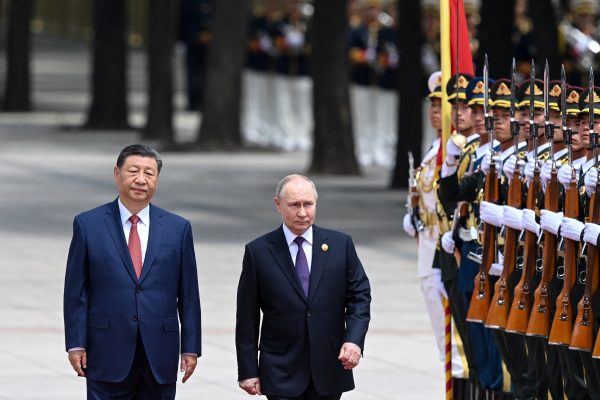Russia’s approach to the Black Sea is, according to former US Sixth Fleet commander and CEPA distinguished fellow, Admiral James Foggo, “like a boa constrictor around Ukraine’s neck, squeezing and squeezing and squeezing.” The alliance “needs a maritime strategy.”
Much has been said about this (here, and here, and here), but the war has made progress difficult. The last non-littoral NATO warship in the Black Sea, the French frigate FS Auvergne, left in January 2022. Since then, Turkey has closed the straits to warships of both Russia and the alliance.
While Ukraine’s navy has, despite its lack of major surface warships or submarines, successfully inflicted serious damage to Russia’s fleet, the Kremlin’s admirals direct the preeminent naval power on the Black Sea. Naval drone attacks on Sevastopol and ground-based anti-ship missiles have limited the freedom of maneuver of its fleet (and withdrawal of some units to Novorossiysk), but Russia retains a stranglehold on Ukrainian shipping movements, and thereby its main export route.
This has been Russian policy for years, and a post-war Ukraine cannot thrive unless things change. The campaign has for years aimed to increase Russia’s chokehold and it has largely succeeded.
In April 2018, Russia opened the Kerch Bridge to connect illegally annexed Crimea to its mainland. This route has served to aid important elements of Russia’s military logistics and war crimes, such as missile attacks on Ukrainian civilian infrastructure. But it was also (quite deliberately) designed to limit Ukrainian shipping, by reducing the size of vessels that could enter and exit the Azov Sea and Ukrainian ports like Mariupol. Not for nothing is it known as the “Kerch noose.”
Next, Russia began to intentionally delay commercial vessels heading to and from Ukrainian Azov ports under the pretext of inspections. There were no delays for Russian vessels heading to/from Russian ports in the region.
Before the inspections, the average waiting time for commercial vessels to pass through the Kerch Strait was 5-7 hours. This increased to 80-115 hours in the second half of 2018. Western anger at this naked political interference with the free movement of merchant ships saw Russia reduce delays to an average of 37 hours in 2019, but thereafter Russia raised or shortened delays at will, often as a tool against the threat of sanctions by EU countries.
Russia’s third tactic was to close areas of the Black Sea and the Sea of Azov under the pretext of naval drills. Since February 8, 2022, Russia has used this to block important areas of the Black and Azov Seas on routes to and from all Ukrainian ports. In addition, its closed area extended to Ukraine’s exclusive maritime economic zone. Since the all-out war began, Russia has also fired on non-belligerent merchant vessels. Sea mining, and their detachment and drifting presents another serious risk for navigation.
Russia has now created an economic dead zone for Ukraine through its multidimensional blockade of Ukrainian Black and Azov Sea ports and has de facto monopolized a large part of the maritime domain. There are six littoral states on the Black Sea (including three NATO members) but that is far from obvious when looking at the current mess. Russia is dictating events.
Among other things, this allows Russia to use the grain export deal (whose renewal is currently “hanging by a thread”) as a blackmail tool and to squeeze Ukraine out of the global food market. Ukraine is one of the world’s top five grain exporters, but its capacity to export by land is limited to 5-10% of exports while shipping through the maritime grain corridor can be stopped at any moment. As a result of Russia’s occupation of parts of Kherson and Zaporizhzhya oblasts, among its key agricultural regions in Ukraine, 30% of Ukraine’s territory is not available for growing crops, at least in 2023. Meanwhile, Russia had a record grain harvest in 2022. It can thus seek to replace Ukrainian grain exports with its own.
So, what to do? Romania has made suggestions that NATO establishes a permanent naval presence and is presumably willing to offer bases. Turkey has in the past warned that the Black Sea is becoming “a Russian lake.”
Despite the limitations of the 1938 Montreux Convention on the passage into the Black Sea of warships from non-littoral states, NATO could quite easily use Romania’s established shipbuilding tradition to produce small vessels, including unmanned drones. It could deploy multinational crews to these vessels. It could base aircraft and drones in Bulgaria and Romania (Turkey too, if it was willing.) It could press Turkey to adopt a more permissive understanding of Montreux.
What it cannot do is allow the current Russian dominance to continue unchallenged. It is antipathetic to Ukrainian statehood and simply intolerable that a country is beholden to another when using its primary export route to supply the world with its food.
Olya Korbut is a sanctions analyst at the Black Sea Institute of Strategic Studies (Ukraine) and an In-resident Fellow at the Center for European Policy Analysis (CEPA, Washington, DC). She has worked on OSINT monitoring and analysis of Black Sea militarization by Russia since 2014.
Europe’s Edge is CEPA’s online journal covering critical topics on the foreign policy docket across Europe and North America. All opinions are those of the author and do not necessarily represent the position or views of the institutions they represent or the Center for European Policy Analysis.





